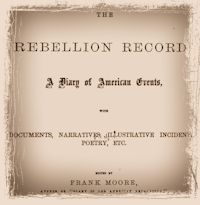April 12.—Information having been received by General King, commanding at Yorktown, Va., of the presence of a large body of cavalry in Gloucester County, Colonel A. H. Grimshaw, Fourth Delaware volunteers, in command of the post at Gloucester Point,, was ordered to send out a detachment of infantry for the purpose of reconnoitring the enemy’s position, and, if possible, driving him from some mills which he was reported to occupy, about ten miles beyond the Union lines. Lieutenant-Colonel Tevis, Fourth Delaware, started out at two P.M., with one hundred and fifty volunteers from his own regiment, and having ascertained the force of the rebels to be about two hundred cavalry, under the command of Colonel Goodwin, pushed forward to attack them. The enemy fell back, leaving, however, two of their pickets in the hands of the Nationals. They were ridden down and captured by Colonel Tevis, Lieutenant Tower and Dr. Hopkins, surgeon of the regiment. The detachment returned to camp about nine o’clock P.M., having burned a saw-mill and two large gristmills, filled with grain and flour, for the use of the rebels in Richmond. The prisoners belonged to Fitz-Hugh Lee’s regiment, the Fifth Virginia cavalry. They were well armed, and carried printed orders, signed by J. E. B. Stuart, to seize a number of horses for the use of their regiment, “to replace those killed or disabled during the last campaign.”—Philadelphia Inquirer.
—Lieutenant-Colonel Edgar A. Kimball, of Hawkins’s Zouaves, Ninth regiment of New York volunteers, was killed by General Michael Corcoran, at a point near Suffolk, Va.



